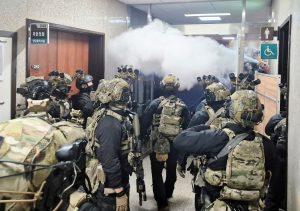South Koreans began casting their ballots in record numbers on Thursday as early voting opened for the country’s snap presidential election, set for June 3, following months of political upheaval triggered by former President Yoon Suk Yeol’s failed attempt to impose martial law.
The snap vote aims to fill the power vacuum left by Yoon’s ousting in December and restore political stability in Asia’s fourth-largest economy. Early voting, allowed over two days, saw 3.1 million people—7% of the electorate—cast their ballots by 11 a.m. Thursday, marking the highest turnout for this stage of a presidential election, according to the National Election Commission (NEC).

South Korea’s ousted President Yoon Suk Yeol, who is facing charges of orchestrating a rebellion when he declared martial law, arrives to attend his trial at the Seoul Central District Court in Seoul, South Korea, Monday, May 12, 2025. Ahn Young-joon/Pool via REUTERS TPX IMAGES OF THE DAY
The election will be decided in a single round, with the candidate securing the most votes set to serve a five-year term. With 44.39 million eligible voters, including 205,000 overseas voters, South Korea is witnessing one of its most closely watched and consequential elections in recent history.
Frontrunner Lee Jae-myung: From Political Survivor to Favorite
Leading the race is Lee Jae-myung, the liberal candidate from the Democratic Party, who has staged a remarkable political comeback after surviving a knife attack, criminal indictments, and an attempt by Yoon to sideline him during the martial law episode. Lee, who narrowly lost the 2022 presidential race, was seen leading in the final polls before a blackout on Wednesday with 49% support.
Casting his ballot in Seoul, Lee urged voters to “start again as a Korea of recovery and growth.” He has pledged to create a new Ministry of Climate and Energy and reorganize the Gender Equality Ministry to tackle both the climate crisis and social equity.

Lee Jae-myung, the presidential candidate for South Korea’s Democratic Party, votes during early voting for the upcoming presidential election with his supporters at a polling station in Seoul, South Korea, May 29, 2025. Yonhap via REUTERS THIS IMAGE HAS BEEN SUPPLIED BY A THIRD PARTY. NO RESALES. NO ARCHIVES. SOUTH KOREA OUT. NO COMMERCIAL OR EDITORIAL SALES IN SOUTH KOREA.
Lee’s platform emphasizes economic recovery through investment in artificial intelligence and pop culture industries, while promoting unity and engagement with North Korea. He has softened earlier populist stances, now supporting pro-business reforms, tax credits for companies, and easing restrictions on working hours.
Despite facing trials on multiple charges—including a $1-billion property scandal and alleged fund transfers to North Korea—many cases have been postponed until after the vote. If convicted in future rulings, they could still cast a long shadow over his presidency.
Conservative Rivals: Kim Moon-soo and Lee Jun-seok
Lee’s closest rival is Kim Moon-soo of the conservative People Power Party, polling at 35% before the blackout. A former labor minister and staunch Yoon ally, Kim launched his campaign by highlighting small business support and has promised tax cuts, deregulation, and a tougher stance on North Korea.

Kim Moon-soo, the presidential candidate for South Korea’s conservative People Power Party, votes during early voting for the upcoming presidential election at a polling station in Incheon, South Korea, May 29, 2025. Yonhap via REUTERS THIS IMAGE HAS BEEN SUPPLIED BY A THIRD PARTY. NO RESALES. NO ARCHIVES. SOUTH KOREA OUT. NO COMMERCIAL OR EDITORIAL SALES IN SOUTH KOREA. TPX IMAGES OF THE DAY
Kim backs a possible nuclear weapons program through reprocessing fuel and seeks to reopen negotiations with U.S. President Donald Trump over trade tariffs. He also proposes reviving nuclear energy to meet growing industrial demands.
However, Kim’s campaign has been complicated by the presence of another conservative, Lee Jun-seok, a 40-year-old from the New Reform Party who holds 11% support. Kim has failed to convince Lee to step aside, potentially splitting the conservative vote.

Lee Jun-seok, the presidential candidate for South Korea’s New Reform Party, casts his early vote for the upcoming presidential election at a polling station in Hwaseong, South Korea, May 29, 2025. Yonhap/via REUTERS ATTENTION EDITORS – THIS IMAGE HAS BEEN SUPPLIED BY A THIRD PARTY. NO RESALES. NO ARCHIVE. SOUTH KOREA OUT. NO COMMERCIAL OR EDITORIAL SALES IN SOUTH KOREA.
A Nation at a Crossroads
The 2025 election features no female candidates for the first time since 2007. With 50.5% of the electorate being women and about a third aged over 60, demographic shifts are expected to play a significant role in the outcome. Gyeonggi Province, home to the largest voting bloc, could be a key battleground.
Election day on June 3 is a public holiday, with polls open from 6 a.m. to 8 p.m. Preliminary results are expected the same night or early the next day, with the inauguration of the new president to follow shortly.

People wait in a line to vote during early voting for the upcoming presidential election at a polling station at the Incheon International airport in Incheon, South Korea, May 29, 2025. REUTERS/Kim Hong-Ji
In an effort to ensure transparency, the NEC will broadcast CCTV footage from ballot storage rooms and implement heightened security measures, including police escorts for transported ballots.
As South Korea grapples with economic uncertainty, demographic decline, and regional tensions, voters face a stark choice between competing visions for the nation’s future—one rooted in liberal reform and diplomacy, the other in conservative strength and deregulation.
The stakes, for both South Korea and the wider region, could not be higher.








